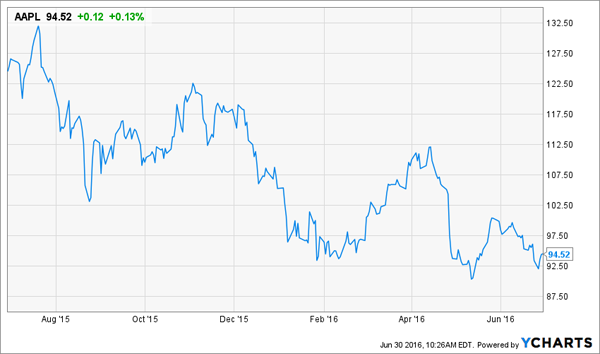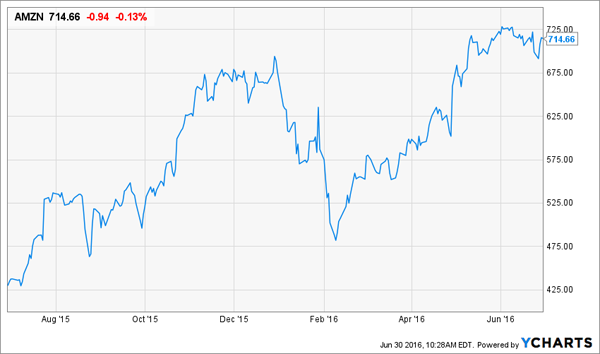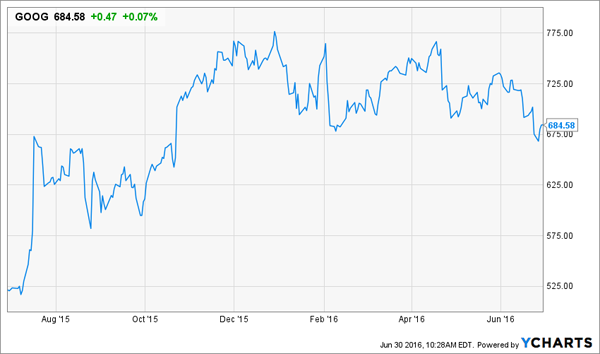Dividend growth investors today are lucky to get 3% from their large cap stocks while tech investors endure painful volatility without any short-term reward. But I know how to get the best of both worlds with a 4-fund tech portfolio that generates 8.5% income. Best of all, you can collect these yields while you wait for these companies’ massive growth to drop through to their bottom line into shareholders’ pockets.
How? Simple: covered calls. Well, not so simple—call options are a complicated strategy that, if used without care and guidance, can turn a portfolio into a big loser. So we must create a portfolio that we can trust while selling options that won’t get assigned. After all, we’re doing this for secure yield.
What’s in this “tech income portfolio” and why are these low-to-no-yield stocks actually ideal income generators? Read on to find out.
Apple’s Cheap Moat
Apple (AAPL) is dirt cheap, it has a wide moat and it’s flush with cash. The firm has been generous with shareholders, returning almost $90 billion in share buybacks over the last three years. On top of that, Apple pays out $12.5 billion per year in dividends, with a nice 2.4% yield. Those dividends have been growing steadily over the last four years, meaning your income will only go up as long as you keep your shares.
That doesn’t mean the market has rewarded Apple for its generosity, though.
Apple Shares Slide

Down 9% for the year, driven mostly by fears that iPhone sales growth has stopped, the stock has disappointed tech investors. But for call sellers, this simply means that your options, at a $100 strike price, aren’t getting exercised; because of that, you can collect an annualized 8.8% income from those option premiums on top of the 2.4% yield. Yes, you can net a double-digit income stream (11.2% to be specific) from Apple.
Getting Amazon’s Strength and Cash, Too
Our next stock is far from cheap: Amazon (AMZN) has stunned investors over the past year with its ability to continually grow sales and earn a profit when it wants to. True to its name, Amazon is looking to become a massive market player, investing in everything from drones to food delivery to streaming services.
Amazon on a Roll

Thanks to this, Amazon shares are up 6%, almost eradicating the decline in Apple. But you can also collect cash from Amazon, via my covered calls at a 775 strike price. This is far above its all-time high, so the chances of those options being exercised are next to nil—and if they are, it will just mean a 7.7% capital gains from the stock’s current price. In the meanwhile, you’ll collect a massive income stream worth 11.6% of your holdings—again proving that tech can mean high yield, too.
Google’s Stable Price Means High Income, Low Risk
Our third stock has not done well in 2016, although it’s up over 32% over the past year: Google (GOOG), which has remained mostly range-bound over the last eight months after a massive quarter drove shares higher a year ago:
Google Sleeps After Tearing Higher

That low volatility makes it easy to sell a call at a $780 strike price, just shy of the 52-week high. I’m getting a 6.1% annualized yield from these options—an impressive return for a company that pays no dividends and sees double-digit revenue growth every quarter.
Netflix Decline Means Cheap Growth, High Premiums
The final stock in our high yield tech portfolio is Netflix (NFLX), whose 7:1 split a year ago has made it much easier for a covered call strategy. Also, the stock has been choppy but range-bound since then, again making it a strong covered call candidate:
Sideways Netflix

Netflix’s massive revenue and subscription growth have made it a hedge fund favorite for years, but the major uptrend in the company’s stock price has come to a standstill. That’s great for us income hounds, though—our 120 strike price calls look unlikely to get exercised, so we can keep the premiums worth 7.4% in annualized income while we wait for a breakout in the share price.
And it will break out eventually. With future expansion opportunities worldwide still in front of the company and cord cutting still a major trend in America, there’s little reason to think this stock won’t keep providing strong subscription and revenue growth to justify its massive 314 P/E ratio.
A Glance at the Portfolio
The makeup of this portfolio is somewhat simple—although there is a bit of a problem in replicating its results. First, let’s look at the breakdown:

What we’ve done is bought 100 shares of each stock and sold 1 call against those shares with an expiration date six months out; currently, that means our options expire in January.
This means we need to sell options twice a year; while we could sell them more frequently and possibly get a bigger income stream, that’d mean more exposure to short-term market volatility and increase our risk of the options being exercised.
Instead, we can keep transaction costs down and risks minimal by going out a few months more for an average yield on my holdings of 8.5% (even before Apple’s dividends.)
The only problem with this strategy: it’s expensive. To buy 100 shares of Amazon, you need to commit over $71,500, and the entire portfolio will cost over $160,000. That’s a lot of money to commit to just one sector and one strategy.
Fortunately, there are funds that replicate this kind of covered call strategy with these and other high quality growth stocks that may offer capital gains upside if they get a breakout. Until that happens, the call options that these funds sell are giving the fund and its investors a strong income stream that is durable and actually benefits from shocks to the market, like the recent Brexit scare that brought the market down 5%—only to see it recover in a matter of days.
Beyond covered calls, there are other ways to get high dividends from mega-cap, high quality companies that many investors overlook: the bond market. But we aren’t just talking about buying corporate bonds; we mean bond funds that have recently gotten big investments from billionaire hedge fund managers who see major rewards in buying and holding funds that give an income stream of 7% or more. If you want to know more about these funds, click here.
